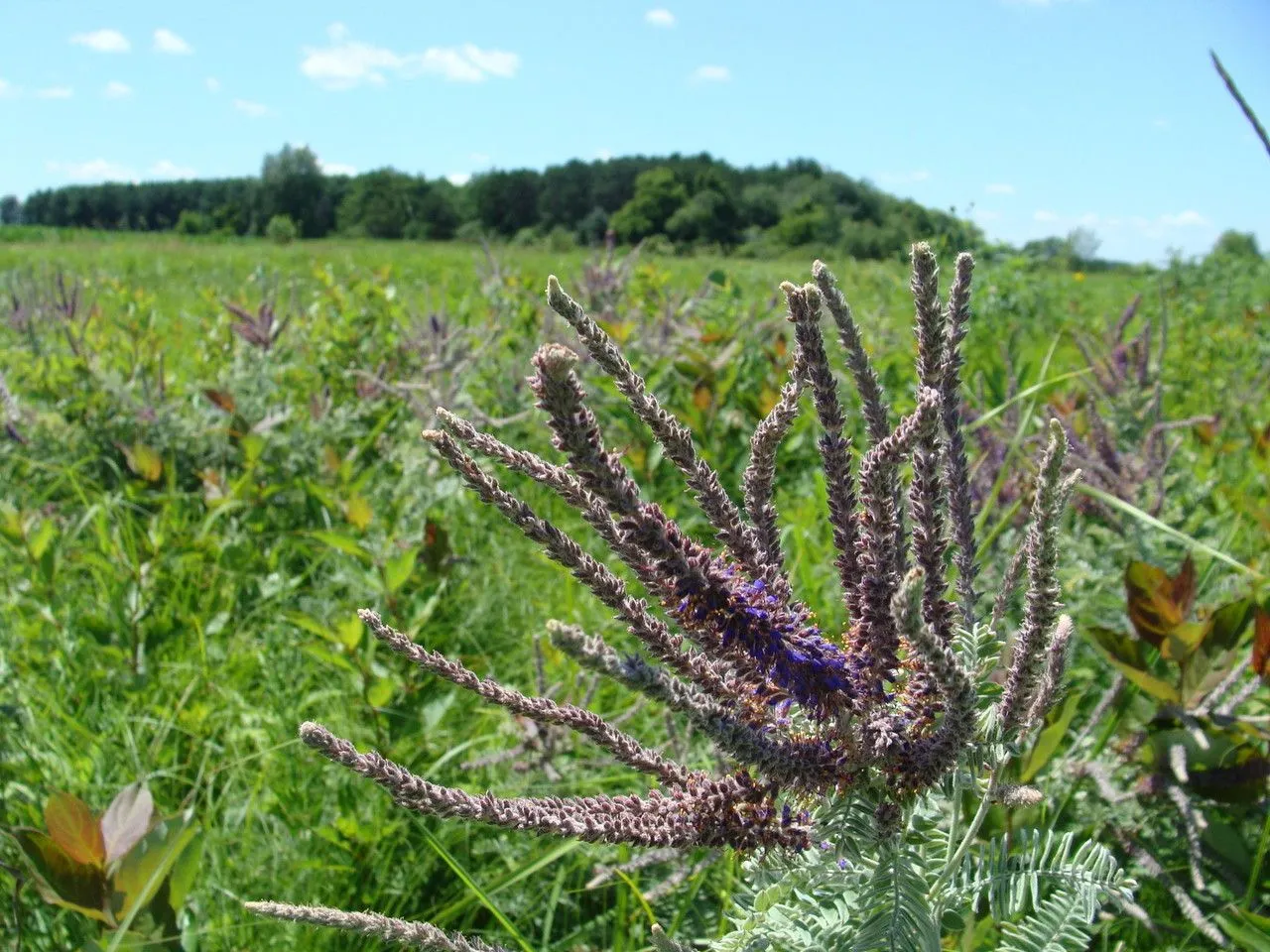
Author: Pursh
Bibliography: Fl. Amer. Sept. 2: 467 (1813)
Year: 1813
Status: accepted
Rank: species
Genus: Amorpha
Vegetable: Unknown
Observations: WC. & EC. U.S.A.
Leadplant, scientifically known as Amorpha canescens, is a notable member of the Fabaceae family. Since its first description in 1813 by the botanist Pursh, it has garnered interest primarily for its unique botanical characteristics and its role within the ecosystems of the Western and Eastern United States.
Typically found in prairies and open savannas, Leadplant is a perennial shrub that epitomizes resilience and adaptability. It can grow to about one to three feet in height, characterized by its woody stems and dense, greyish-green foliage that gives it a somewhat leaden appearance, hence the common name. The compound leaves are pinnate and consist of numerous small leaflets, covered with fine hairs that contribute to the plant’s distinctive coloration and texture.
During its blooming period, which generally occurs from early to mid-summer, Leadplant produces striking flower spikes adorned with small, purple flowers. Each flower is complemented by conspicuous orange stamens, creating a contrast that is not only visually appealing but also highly attractive to various pollinators, including bees and butterflies.
Amorpha canescens plays a crucial ecological role, particularly in prairie restoration projects. Its deep root system helps in soil stabilization and contributes to the soil’s nitrogen content through its symbiotic relationship with nitrogen-fixing bacteria. As a tough, drought-tolerant species, it is well-suited to withstand harsh environmental conditions, making it an excellent candidate for use in sustainable landscaping practices.
Culturally, Leadplant holds significance among various Native American tribes who have utilized it for medicinal purposes. Infusions made from its leaves and flowers were traditionally used to treat ailments such as rheumatism and neuralgia, showcasing its versatility beyond mere aesthetics.
In summary, Leadplant (Amorpha canescens) stands out not only for its distinctive appearance and adaptability to the American prairies but also for its ecological and cultural value. Its ability to enhance soil quality and attract pollinators underscores its importance in both natural and designed environments, reinforcing its status as a plant worth recognizing and preserving.
Eng: leadplant, downy false indigo, downy indigo-bush, leadplant amorpha, wild tea
Swe: grå segelbuske
Fra: faux-indigo blanchissant, buisson à plomb
En: Leadplant, LEADPLANT AMORPHA, Downy false indigo, Downy indigo-bush, Wild tea
Ar: ناقصة شيباء
Fi: Tuhkasulkapensas
Fr: Faux-indigo blanchissant, Buisson à plomb
Ru: Аморфа седоватая
Sv: Grå segelbuske
© copyright of the Board of Trustees of the Royal Botanic Gardens, Kew.
Taken Jul 16, 2021 by Laurie Tanenbaum (cc-by-sa)
Taken Aug 16, 2019 by The Raven Girl (cc-by-sa)
Taken Jan 30, 2021 by Prescott Bergh (cc-by-sa)
Taken Oct 9, 2019 by Marco Cuevas (cc-by-sa)
Taken May 29, 2019 by Rafa Pizarro (cc-by-sa)
Taken Sep 5, 2021 by Shuji Usui (cc-by-sa)
Taken Jul 27, 2021 by Shuji Usui (cc-by-sa)
Taken Jul 27, 2021 by Shuji Usui (cc-by-sa)
Taken Aug 1, 2019 by Alin (cc-by-sa)
Taken Aug 1, 2019 by Alin (cc-by-sa)
Taken Jun 11, 2019 by Arruda Lauryn (cc-by-sa)
Taken Aug 1, 2019 by Alin (cc-by-sa)
Taken Jul 27, 2021 by Shuji Usui (cc-by-sa)
Taken Jun 15, 2019 by Lucidi Vincenzo (cc-by-sa)
Taken May 29, 2019 by Rafa Pizarro (cc-by-sa)
Taken Aug 2, 2015 by EOL − Lynn Michael (cc-by-nc)
Taken Aug 3, 2015 by EOL − Lynn Michael (cc-by-nc)
Taken Jul 11, 2015 by EOL − sarapar (cc-by-nc)
Taken Aug 10, 2015 by EOL − Christine (cc-by-nc)
Taken Jul 9, 2014 by EOL − Daniel Carter (cc-by-nc)
Taken Jun 3, 2020 by Aaron Harp (cc-by-sa)
Family: Myrtaceae Author: (F.Muell.) K.D.Hill & L.A.S.Johnson Bibliography: Telopea 6: 402 (1995) Year: 1995 Status:…
Family: Rubiaceae Author: Pierre ex A.Froehner Bibliography: Notizbl. Bot. Gart. Berlin-Dahlem 1: 237 (1897) Year:…
Family: Sapindaceae Author: Koidz. Bibliography: J. Coll. Sci. Imp. Univ. Tokyo 32(1): 38 (1911) Year:…
Family: Asteraceae Author: A.Gray Bibliography: Pacif. Railr. Rep.: 107 (1857) Year: 1857 Status: accepted Rank:…
Family: Fabaceae Author: Medik. Bibliography: Vorles. Churpfälz. Phys.-Ökon. Ges. 2: 398 (1787) Year: 1787 Status:…
Family: Aspleniaceae Author: (Cav.) Alston Bibliography: Bull. Misc. Inform. Kew 1932: 309 (1932) Year: 1932…